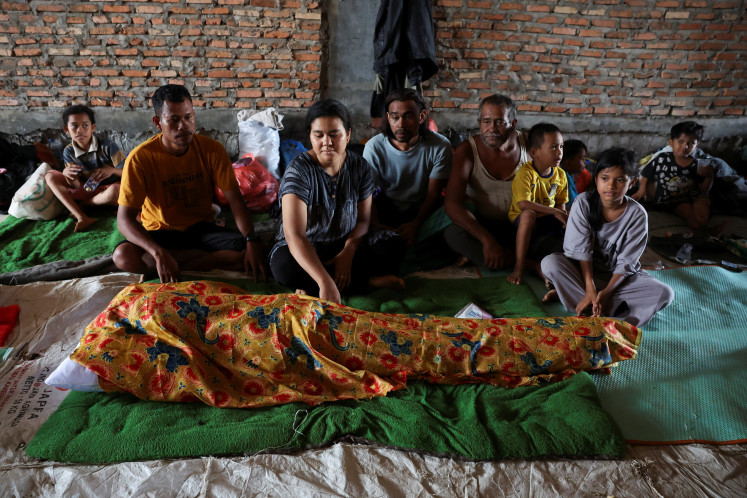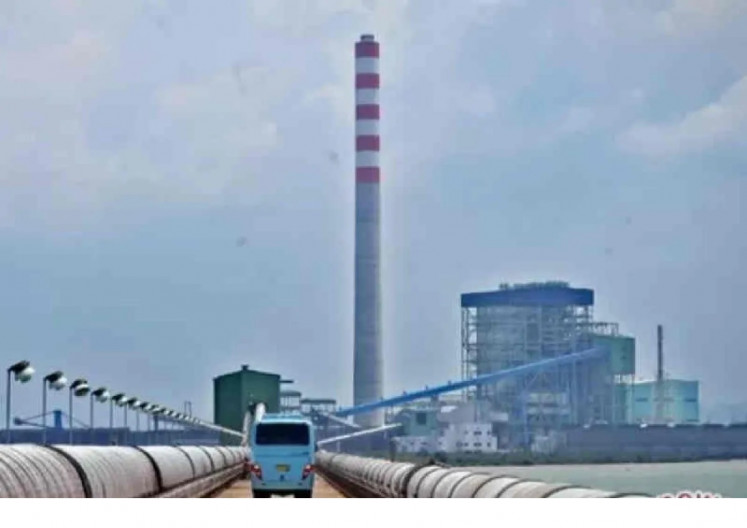Popular Reads
Top Results
Can't find what you're looking for?
View all search resultsPopular Reads
Top Results
Can't find what you're looking for?
View all search results'Coal-by-wire' from Sumatra to Java
Coal from the island of Sumatra accounts for most of Indonesiaâs low-grade lignite, a low-quality coal that receives a poor price in international markets
Change text size
Gift Premium Articles
to Anyone
C
oal from the island of Sumatra accounts for most of Indonesia's low-grade lignite, a low-quality coal that receives a poor price in international markets.
Given this low pricing combined with high transportation costs and the fact that most reserves are located in landlocked areas, it is not feasible to export Sumatra's coal out of the island.
It is more efficient to use Sumatra's coal for a mine-mouth power plant, an approach in which we develop a power plant very close to where mines are located, use the low-calorie coal from the mines to feed the plant, and transmit the electricity, rather than transporting a low-value commodity, out of the mines.
With mine-mouth, we no longer require either barges or expensive railway-heavy infrastructure to transport coal; rather we need to have long-distance high-voltage transmission lines to bring 'coal-by-wire' from mines to consumer centers, either regions in Sumatra and/or Java-Bali.
Essentially, with 'coal-by-wire' we are transporting a higher-value commodity by wire from mines to customers. Coal stays in the landlocked areas and feeds mine-mouth, coal-fired power plants.
'Coal-by-wire' would definitely boost the development of a domestic market for low-grade coal. Today, our market for coal is very thin as we are one of the world's leading exporters of thermal coal of a high quality in the international market.
Our exports have increased very significantly within the past decade on account of demand from fast-growing Asian economies. More than 80 percent of our coal currently produced is exported.
Indeed, coal is currently the most important source of energy for our economy. For decades coal has accounted for more than half of our power-generation capacity. And this will continue for a half century to come before alternative and cleaner energy sources other than coal become affordably available.
Our economy is also growing, and of course will require more electricity power and therefore coal ' challenges that have to be met. Electricity generation now consumes close to 75 million tons per year, and will almost triple in the next 10 to 15 years.
However, domestic use of coal today notoriously suffers from infrastructure bottlenecks. Congested barges and ports, as well as a shortage of railways limit the transportation of coal from coalmines in two coal-producing regions, Kalimantan and Sumatra, to demand centers in Java-Bali, where most of our power plants are located.
The majority of our coal reserves in the two regions are located in landlocked areas that require rail transportation infrastructure to reach ports for export.
Either truck haul or rail is needed to transport the coal to barge ports and terminals.
Truck operating costs are about twice that of rail, but existing rail transportation infrastructure is severely insufficient.
Indonesia's attempts to improve coal-transport infrastructure for the domestic market have not been very successful. Dedicated coal ports in Kalimantan have been planned for many years, but implementation has again faced bottleneck issues.
Specialized railways for coal in Sumatra have also been initiated, but this concept is still under development and has not yet received a higher-level mandate or legal authorization.
Delays in expanding the capacity of barge and transportation infrastructure cause inefficiencies and high transportation costs in domestic coal utilization. These high costs and infrastructure bottlenecks have held back the development of the domestic market for coal.
Our high-voltage transmission lines are also astonishingly limited. The state-owned electricity company (PLN) operates approximately 40,000 kilometers of transmission lines, with less than 15 percent of this total serving the island of Sumatra.
If we can build more mine-mouth, coal-fired power generation plants we will need to expand our transmission network across the island, interconnected to other transmission systems in Java-Bali.
A new set of lines of a high-voltage of 500 kilovolts and medium-voltage of 275 kV needs to be developed as a backbone network across the island, i.e. providing long-distance, reliable and stable transmission.
The distribution system and transformer capacity also need to be expanded to service a larger coverage of costumers and demand centers.
We are required also to develop an interconnected transmission system, as existing electricity transmission is not compatible across regions due to different systems and manufacturer standards adopted in the past.
The current initiative of developing inter-island interconnection lines between Java and Sumatra with 500kV High Voltage Direct Current (HVDC) lines needs to be completed in harmony with the mine-mouth development.
These long-distance transmission and distribution lines, as well as interconnected systems are required to exist before a system of mine-mouth power plants is commissioned to ensure that electricity produced can be transmitted in a timely manner and with minimum cost.
Both the central and local governments must work hand-in-hand to endorse incentives to encourage the private sector ' independent power producers (IPPs) ' to develop mine-mouth power plants.
Incentives need to be designed to enhance the financial viability of IPPs' mine-mouth power plant projects.
PLN as an off-taker of IPP plays a fundamental role as the 'coal-by-wire' agent, and has to be ready to absorb all of the risks associated with the development and operation of the system, including the difficulties in land acquisition and intra-regional compatibility of transmission systems.
Sumatra with its huge resources of low-grade coal can secure its own electricity supply and, eventually, can be the source of low-cost electricity with its energy radiating not only to Java, but also to every corner of the country.
___________________
The writer is deputy for energy and mineral resources at the office of Coordinating Economic Minister.










